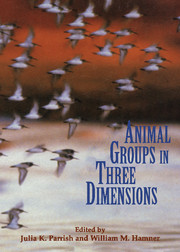Book contents
- Frontmatter
- Contents
- List of contributors
- Acknowledgments
- 1 Introduction – From individuals to aggregations: Unifying properties, global framework, and the holy grails of congregation
- Part one Imaging and measurement
- Part two Analysis
- Part three Behavioral ecology and evolution
- Part four Models
- 16 Conceptual and methodological issues in the modeling of biological aggregations
- 17 Schooling as a strategy for taxis in a noisy environment
- 18 Trail following as an adaptable mechanism for popular behavior
- 19 Metabolic models of fish school behavior – the need for quantitative observations
- 20 Social forces in animal congregations: Interactive, motivational, and sensory aspects
- References
- Subject index
- Taxonomic index
19 - Metabolic models of fish school behavior – the need for quantitative observations
from Part four - Models
Published online by Cambridge University Press: 01 June 2010
- Frontmatter
- Contents
- List of contributors
- Acknowledgments
- 1 Introduction – From individuals to aggregations: Unifying properties, global framework, and the holy grails of congregation
- Part one Imaging and measurement
- Part two Analysis
- Part three Behavioral ecology and evolution
- Part four Models
- 16 Conceptual and methodological issues in the modeling of biological aggregations
- 17 Schooling as a strategy for taxis in a noisy environment
- 18 Trail following as an adaptable mechanism for popular behavior
- 19 Metabolic models of fish school behavior – the need for quantitative observations
- 20 Social forces in animal congregations: Interactive, motivational, and sensory aspects
- References
- Subject index
- Taxonomic index
Summary
Introduction
There is extensive literature on fish schooling emphasizing school architecture and how behavioral interactions drive school structure. In fact, studies of schooling have focused almost exclusively on biotic forces – predation, foraging, reproduction- experienced by schoolers (see review in Pitcher & Parrish 1993). How schoolers interact with the physical environment has received little attention, despite the fact that physiological constraints can have a dramatic effect on survivorship in the short term. For example, how the physiology of schooling organisms affects the chemistry and nutrient loads of the water masses that they occupy has been virtually ignored. Changes in water chemistry can alter the quality of the environment such that it is locally inhospitable. Field observations reveal that fish schools can alter dissolved respiratory gases (McFarland & Moss 1967) and increase ammonium and nutrient concentrations (Oviatt et al. 1972 Meyer et al. 1983 Bray et al. 1986), and that their foraging activities can greatly reduce zooplankton concentrations (Bray 1980 Koslow 1981 Hamner et al. 1988). It is entirely possible that physiological constraints may place limits on school size, density, shape, and internal arrangement. Unfortunately, few investigations demonstrate what effect(s) these metabolically related changes may have on schooling behaviors (Moss & McFarland 1970).
Although the structure of a fish school can be influenced by innumerable factors, McFarland and Moss (1967) suggested that many of the dynamic internal changes observed in school structure and shape could be a response to lowered ambient oxygen and/or increased carbon dioxide concentrations. If decreased oxygen, increased carbon dioxide, and increased ammonium levels in the water can be deleterious to fish, then individual movements within dense schools may be modifications to minimize the exposure to deleterious conditions.
Information
- Type
- Chapter
- Information
- Animal Groups in Three DimensionsHow Species Aggregate, pp. 301 - 312Publisher: Cambridge University PressPrint publication year: 1997
Accessibility standard: Unknown
- 3
- Cited by
